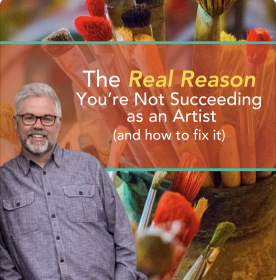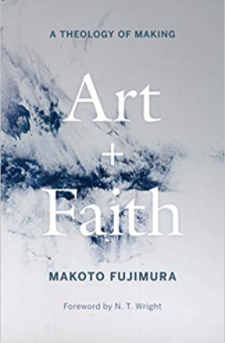Have you ever felt like your creativity was trapped behind an invisible wall? Like no matter how many tutorials you watch, books you read, or marketing tactics you try, you just can’t seem to find your rhythm again?
You’re not alone.
As Christian artists, we’re not just trying to master a technique or build a business—we’re trying to honor God with our creativity. And that means the roadblocks we face aren’t always technical… they’re spiritual, emotional, and deeply personal.
I created the Foundations Course™ because I’ve walked that road myself—and I’ve helped thousands of artists just like you find freedom, purpose, and joy on the other side of their struggle.
“This course didn’t just make me a better artist. It made me a whole person.” – Anita C.
What Artists Are Really Struggling With
Most artists don’t struggle with making art. They struggle with:
- Fear of not being good enough
- Comparison to other artists
- Feeling overwhelmed or disorganized
- A lack of confidence in their calling
- Uncertainty about how God fits into their creative life
And that struggle? It doesn’t get better with more strategy. It only gets better when you deal with what’s going on in your heart.
“I’ve been a believer for decades… this course helped me finally understand my identity in Christ as an artist.” – Linda A.
Why Strategy Isn’t Enough
Let’s be honest—strategy can help. But without identity, alignment, and healing, you’ll stay stuck.
“I no longer feel pressure to strive for success. My job is simply to create and trust that God will take care of the rest.” – Shannon
What I’ve found is that when artists begin to see themselves the way God sees them, everything shifts. They stop creating out of fear and start creating from rest. They stop comparing and start connecting. They stop hiding and start shining.
“I feel free—free to create, free to dream again, and free to follow God’s plan without fear.” – Janice M.
What Makes the Foundations Course Different?
The Foundations Course isn’t just about art—it’s about you. It’s about your heart, your healing, and your walk with God as a creative.
Inside the course, you’ll discover:
- How to renew your mind using biblical truth
- How to overcome perfectionism, fear, and creative paralysis
- How to create from a place of freedom, not striving
- How to align your art with your Kingdom calling
- How to cultivate confidence in your identity as God’s artist
“It’s like someone finally turned the lights on. I can see what God is doing in and through my creativity.” – Paul H.
This is discipleship for artists. It’s not fluff. It’s not hype. It’s the real, Spirit-led transformation your soul has been crying out for.
Real Stories of Real Transformation
“This course changed my life! It opened the door to hear God’s voice more clearly, and now I create with joy and confidence.” – Brenda W.
“The clarity I now have about my calling is unlike anything I’ve ever experienced. I finally feel aligned with God’s purpose for my creativity.” – Joanne C.
“I’m 74, and I thought I was too late to take my art seriously. This course gave me clarity, healing, and a renewed sense of purpose!” – Roxanne S.
Ready to Begin?
Maybe you’re reading this and thinking, “That’s me. I’m ready. I just need help getting started.”
There are two ways you can begin your Foundations journey right now:
📘 1. Grab the Foundations Book
Perfect for artists who want a physical, guided journey with Scripture, journaling prompts, and creative activations. It’s also a great tool for small groups and church art communities.
💻 2. Enroll in the Full Online Course
If you want video teaching, coaching, a thriving community, and $2000+ in bonuses to accelerate your growth, this is the path for you.
👉 Enroll in the Foundations Course
Overcoming the Price Objection: What’s Staying Stuck Costing You?
I get it—spending money on a course feels like a risk. But let me ask you: What is staying stuck costing you?
Your peace?
Your purpose?
Your ability to show up and create the way God designed you to?
This course is an investment in your healing, your clarity, and your future as a thriving Christian artist. And honestly? You’re worth it.
“Before this course was even over, God opened unexpected doors for me! I would have talked myself out of the opportunity before, but this time, I said ‘YES!’” – Wendy B.
You’re Not Too Late. You’re Right on Time.
There is no expiration date on your calling. Whether you’re 24 or 74, your creativity still matters. Your voice still matters. And God still wants to move in and through your art to reveal His glory.
“I encountered God in this course. He healed my heart, spoke life over my creativity, and gave me a vision for what’s next.” – Darlene K.
“This course revealed God’s vision for my creativity and healed wounds I didn’t know I had. I’ve gone from doubting my artistic calling to recognizing it as a divine assignment.” – Barbara D.
🎯 Final Call to Action
If you’re ready to…
✅ Overcome fear, comparison, and creative blocks
✅ Align your heart with God’s design
✅ Experience lasting transformation in your art and faith…
Then it’s time.
👉 Enroll in the Foundations Course Now
👉 Get the Foundations Book
You were created to thrive. Let’s walk this journey together.
Cheering you on,
Matt Tommey





























